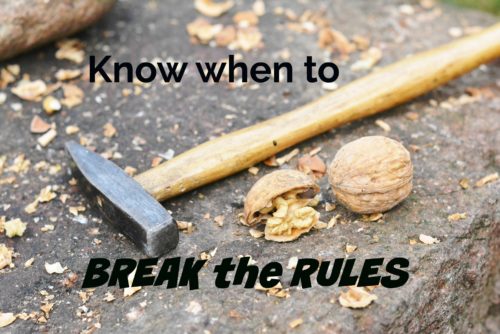
Decluttering and organizational experts have developed some hand rules of thumb to combat the most common clutter problems. These rules have their place, but they are not helpful in every situation. Here are my thoughts on how and when to break the rules.
Store like with like.
What the rule is trying to accomplish: Make consumers aware of the quantity of certain objects they actually own. For example, if paper products are stored in several places, a person might have twenty-five rolls of paper towels without realizing it. If clothing is stored in multiple closets, a person might not realize how many special-occasion outfits they really own. Storing like items in one —and only one—place makes it easy to find what you need and prevents accidental over-buying.
When to break it: When you actually use an item in many different locations, or when the ideal storage area is limited. For example, I keep scissors in all the places I am most likely to use them, including the office, the kitchen, and my box of gift-wrap supplies. I adapt the rule by keeping one spare roll of TP in each bathroom, while the rest is stored in a single cabinet.
Only touch it once.
What the rule is trying to accomplish: Every time a person picks up an item (such as the incoming mail) they spend time thinking about what to do with it. The more times you touch an object without completing the task, the more time you waste. Those who understand the power of this concept resist the urge to pick something up, ponder it, then set it down again somewhere else to “deal with later.” The Touch It Once rule says: The mail comes in the house and right to the in box, (not the kitchen table) ideally after a quick scan to dispose of obvious junk mail and sort out periodicals that get deposited next to your favorite chair.
When to break it: When putting an item away will distract you from the task at hand. For example, when you are in the midst of organizing a room, make a collection of items that belong elsewhere, and put them away after you have finished going through everything.
A place for everything, and everything in its place.
What the rule is trying to accomplish: Clutter often happens when items lay around because they don’t have a designated place to be stored. People don’t put things away when they don’t know where those items belong. Therefore, deciding on the appropriate home for each item is a key to fighting clutter, as is getting in the habit of actually putting things where they belong.
When to break it: When you are in the middle of a multi-day project, it is probably more efficient to leave the various supplies out until the project is finished. (Providing you aren’t expecting houseguests and the project gets completed in a timely fashion.) Another exceptions is when preparing for an event. When I have an upcoming party or vacation, I pile items purchased for that event in a designated hallway off the kitchen rather than putting them away. That way, when it comes time to use them, the items are already collected in one place.
If you haven’t used it in the last year, you don’t need it.
What the rule is trying to accomplish: We all have clothes we don’t wear anymore, knickknacks we’ve grown tired of, or kitchen gadgets we don’t use. This rule a handy way to help people identify those items, so they can get rid of them.
When to break it: When we are intentionally keeping an item for future use. For example, although my children have long outgrown picture books, I’ve kept my favorites, anticipating occasional visits of grandchildren and other youngsters. I have not kept all of them, just a collection of our most-enjoyed volumes. This is not an excuse to keep every item from your kids’ childhood! Consider carefully what will remain in good condition for years (ie, not cute baby outfits with elastic that will become brittle and worthless) and limit yourself to a reasonable amount of storage space.

You hit the nail on the head on all three counts. Tools is another area where “if you don’t use it in a year” breaks down. Having the right tool on hand is critical, whether it is a bundt pan or a circular saw that you may not use every year, but when you need it there are no good substitutes.
Very true. Ditto for certain craft and seasonal items.